MPM 1/72 DC-2
|
KIT #: |
72527 |
|
PRICE: |
$37.40 |
|
DECALS: |
Three options |
|
REVIEWER: |
Carmel J. Attard |
|
NOTES: |
Multimedia kit |

Douglas DC2 ‘Hanssin Jukka’ was a
Finnish Air Force HQ
VIP
transport in 1942. The service history of this DC2 started when Count C.G.Von
Rosen of
Sweden
donated the machine to the Finnish Air Force, having bought the DC2 from AB
Aerotransport. The aircraft was flown to
Finland
in January 1940, and rem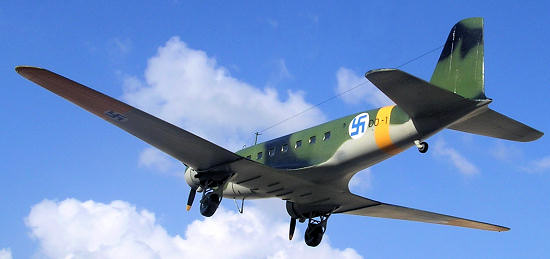 ained
operational until June 1955. This DC2-115-E, production number 1354, was
originally sold to Dutch Airline
KLM
and named “DeHaan”, registered as PH-AKU, and flew in European and Asian skies.
After donation to the Finnish AF the aircraft was fitted with bomb racks and
open dorsal gun position, being designated ‘DC-1’ and named Hanssin Jukka. On
the 1st March 1940
it started its first and also last raid in the Winter War with Llv44, during
which flight an engine was damaged. Eventually the aircraft was repaired and
served with Lentolaivue 46.
ained
operational until June 1955. This DC2-115-E, production number 1354, was
originally sold to Dutch Airline
KLM
and named “DeHaan”, registered as PH-AKU, and flew in European and Asian skies.
After donation to the Finnish AF the aircraft was fitted with bomb racks and
open dorsal gun position, being designated ‘DC-1’ and named Hanssin Jukka. On
the 1st March 1940
it started its first and also last raid in the Winter War with Llv44, during
which flight an engine was damaged. Eventually the aircraft was repaired and
served with Lentolaivue 46.
Having served with a
variety of units, the DC2 was officially written off the books in 1957. In 1958
it served as a coffee lounge in Finnish Hameenlinn. In November 1981 it was
donated to the AF museum where it was renovated. On the anniversary day of the
Finn AF,
6th March 1983,
it emerged at the
Air
Museum
in Tikkakoski where it is still exhibited.
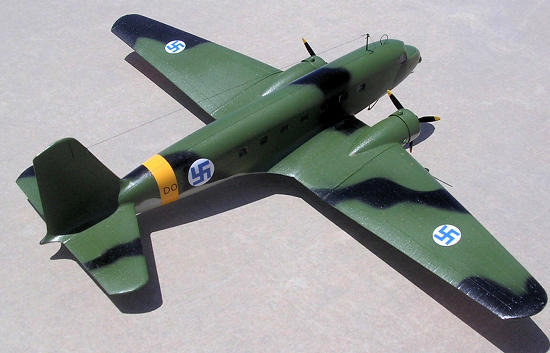 The kit
is moulded in medium grey plastic with fine engrave panel lines that appear to
be accurate and conforms to drawings. It is another high quality kit from MPM,
which can be classified as a multi media type. Apart from the injection-molded
parts the kit contains resin and brass etch items as well as a vac form canopy
for the dorsal turret. The clear parts for the windscreen and side window panels
are injection moulded and are very clear. However I preferred to use Kristal
Kleer. This had a drawback in my case having decided to make the
VIP
version. These carried side curtains to each window, which I could not add as
the Kristal Kleer medium, will not give the desired flat finish if these are
added. The propeller comes as individual blades and there was a choice for using
either injection moulded shaft and central hub or one made of resin.
Still I did not find it a difficult task to build each prop unit.
Alternatively for those who find this hard task they can refer to Aeroclub, who
comes to the rescue with a complete white metal propeller-part number PO-17. Two
resin propeller spinners are also provided in the kit.
The kit
is moulded in medium grey plastic with fine engrave panel lines that appear to
be accurate and conforms to drawings. It is another high quality kit from MPM,
which can be classified as a multi media type. Apart from the injection-molded
parts the kit contains resin and brass etch items as well as a vac form canopy
for the dorsal turret. The clear parts for the windscreen and side window panels
are injection moulded and are very clear. However I preferred to use Kristal
Kleer. This had a drawback in my case having decided to make the
VIP
version. These carried side curtains to each window, which I could not add as
the Kristal Kleer medium, will not give the desired flat finish if these are
added. The propeller comes as individual blades and there was a choice for using
either injection moulded shaft and central hub or one made of resin.
Still I did not find it a difficult task to build each prop unit.
Alternatively for those who find this hard task they can refer to Aeroclub, who
comes to the rescue with a complete white metal propeller-part number PO-17. Two
resin propeller spinners are also provided in the kit.
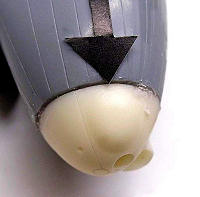 T
T he
kit offers three nose cap parts to choose from. The one adopted for the
VIP
version was the one made of resin, and having one landing light in it. This was
not a perfect fit to the rest of the fuselage, but needed fairing the gap with a
small amount of filler. There are two fin and rudder parts to choose from and
the instructions, as usual with MPM, were easy to follow made it clear which
parts to use. The kit offers three colour options and each comes with the
appropriate extra parts, which includes resin pylons and bombs and very detailed
gun position for the bomber version.
he
kit offers three nose cap parts to choose from. The one adopted for the
VIP
version was the one made of resin, and having one landing light in it. This was
not a perfect fit to the rest of the fuselage, but needed fairing the gap with a
small amount of filler. There are two fin and rudder parts to choose from and
the instructions, as usual with MPM, were easy to follow made it clear which
parts to use. The kit offers three colour options and each comes with the
appropriate extra parts, which includes resin pylons and bombs and very detailed
gun position for the bomber version.
 The
first step of construction is to assemble the cockpit interior. This consists of
two crew seats, a floor, bulkheads, a detailed instrument console, and a pair of
control columns that come in four parts. To the rear of the cockpit there are
two bulkheads and a floor that runs the length of the fuselage. All the interior
was painted slate grey and the whole assembly, using bits of plastic added to
the interior of the fuselage halves as effective aligning guides in the absence
of locating pegs, was closed, forming now a complete fuselage. The wing comes in
five pieces, and although these are butt jointed to the fuselage, the centre
lower section gave all the strength needed needed to complete the job. There are
two parts for the wheel well roof, which were painted and fitted in the wing
parts before these were closed. Going back to the fin and rudder parts, these
could cause a problem unless a secure joint is obtained and allowed enough time
to dry completely. The horizontal tail planes needed some trimming before
fitting in place. Even the main planes required some filling.
The
first step of construction is to assemble the cockpit interior. This consists of
two crew seats, a floor, bulkheads, a detailed instrument console, and a pair of
control columns that come in four parts. To the rear of the cockpit there are
two bulkheads and a floor that runs the length of the fuselage. All the interior
was painted slate grey and the whole assembly, using bits of plastic added to
the interior of the fuselage halves as effective aligning guides in the absence
of locating pegs, was closed, forming now a complete fuselage. The wing comes in
five pieces, and although these are butt jointed to the fuselage, the centre
lower section gave all the strength needed needed to complete the job. There are
two parts for the wheel well roof, which were painted and fitted in the wing
parts before these were closed. Going back to the fin and rudder parts, these
could cause a problem unless a secure joint is obtained and allowed enough time
to dry completely. The horizontal tail planes needed some trimming before
fitting in place. Even the main planes required some filling.
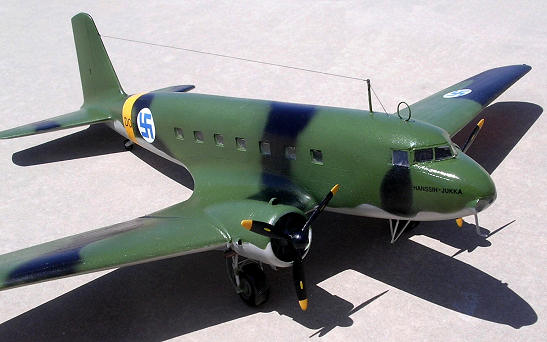 MPM
suggests Humbrol numbers for paint and with Humbrol being a popular brand it was
not difficult to cross reference with alternative brand of colour paints. The
first step I took was to airbrush the areas that are in identification yellow.
These were first given a coat of semi-matt base white. These areas are the
underside of wing tips and the fuselage band. First these areas were given an
undercoat of matt white followed by yellow. These areas were then masked and the
entire underside of the fuselage and wings was airbrushed in light grey. These
areas were masked again and all the upper surfaces were airbrushed in Finnish
medium green. Upon drying the irregular black paint camouflage was applied,
therefore completing the camouflage scheme of the model. Applying the decals
gave very pleasing result, thus adding another important aircraft model and
extend my Finn AF section.
MPM
suggests Humbrol numbers for paint and with Humbrol being a popular brand it was
not difficult to cross reference with alternative brand of colour paints. The
first step I took was to airbrush the areas that are in identification yellow.
These were first given a coat of semi-matt base white. These areas are the
underside of wing tips and the fuselage band. First these areas were given an
undercoat of matt white followed by yellow. These areas were then masked and the
entire underside of the fuselage and wings was airbrushed in light grey. These
areas were masked again and all the upper surfaces were airbrushed in Finnish
medium green. Upon drying the irregular black paint camouflage was applied,
therefore completing the camouflage scheme of the model. Applying the decals
gave very pleasing result, thus adding another important aircraft model and
extend my Finn AF section.
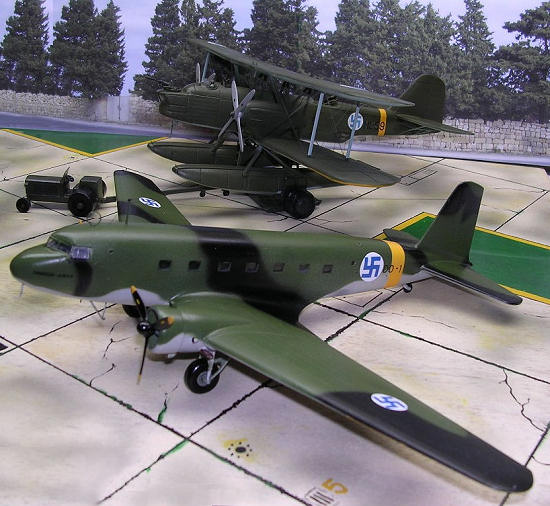 Building
the MPM model required at some stage more time and effort. The unique camouflage
scheme offered very much contrast to other types of colours on WWII aircraft.
However the kit also offers alternative colour finishes to satisfy the keen
modeller be it military (72527) or in separate boxing as a civil type (72508).
Building
the MPM model required at some stage more time and effort. The unique camouflage
scheme offered very much contrast to other types of colours on WWII aircraft.
However the kit also offers alternative colour finishes to satisfy the keen
modeller be it military (72527) or in separate boxing as a civil type (72508).
Carmel J. Attard
March 2011
If you would like your product reviewed fairly and quickly, please
contact
me or see other details in the Note to
Contributors.
Back to the Main Page
Back to the Review
Index Page


 ained
operational until June 1955. This DC2-115-E, production number 1354, was
originally sold to Dutch Airline
ained
operational until June 1955. This DC2-115-E, production number 1354, was
originally sold to Dutch Airline  The kit
is moulded in medium grey plastic with fine engrave panel lines that appear to
be accurate and conforms to drawings. It is another high quality kit from MPM,
which can be classified as a multi media type. Apart from the injection-molded
parts the kit contains resin and brass etch items as well as a vac form canopy
for the dorsal turret. The clear parts for the windscreen and side window panels
are injection moulded and are very clear. However I preferred to use Kristal
Kleer. This had a drawback in my case having decided to make the
The kit
is moulded in medium grey plastic with fine engrave panel lines that appear to
be accurate and conforms to drawings. It is another high quality kit from MPM,
which can be classified as a multi media type. Apart from the injection-molded
parts the kit contains resin and brass etch items as well as a vac form canopy
for the dorsal turret. The clear parts for the windscreen and side window panels
are injection moulded and are very clear. However I preferred to use Kristal
Kleer. This had a drawback in my case having decided to make the 
 he
kit offers three nose cap parts to choose from. The one adopted for the
he
kit offers three nose cap parts to choose from. The one adopted for the
 The
first step of construction is to assemble the cockpit interior. This consists of
two crew seats, a floor, bulkheads, a detailed instrument console, and a pair of
control columns that come in four parts. To the rear of the cockpit there are
two bulkheads and a floor that runs the length of the fuselage. All the interior
was painted slate grey and the whole assembly, using bits of plastic added to
the interior of the fuselage halves as effective aligning guides in the absence
of locating pegs, was closed, forming now a complete fuselage. The wing comes in
five pieces, and although these are butt jointed to the fuselage, the centre
lower section gave all the strength needed needed to complete the job. There are
two parts for the wheel well roof, which were painted and fitted in the wing
parts before these were closed. Going back to the fin and rudder parts, these
could cause a problem unless a secure joint is obtained and allowed enough time
to dry completely. The horizontal tail planes needed some trimming before
fitting in place. Even the main planes required some filling.
The
first step of construction is to assemble the cockpit interior. This consists of
two crew seats, a floor, bulkheads, a detailed instrument console, and a pair of
control columns that come in four parts. To the rear of the cockpit there are
two bulkheads and a floor that runs the length of the fuselage. All the interior
was painted slate grey and the whole assembly, using bits of plastic added to
the interior of the fuselage halves as effective aligning guides in the absence
of locating pegs, was closed, forming now a complete fuselage. The wing comes in
five pieces, and although these are butt jointed to the fuselage, the centre
lower section gave all the strength needed needed to complete the job. There are
two parts for the wheel well roof, which were painted and fitted in the wing
parts before these were closed. Going back to the fin and rudder parts, these
could cause a problem unless a secure joint is obtained and allowed enough time
to dry completely. The horizontal tail planes needed some trimming before
fitting in place. Even the main planes required some filling.
